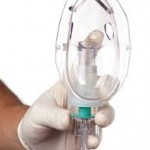 Improving patient tolerance of PAP is one of the main driving forces for the development of alternative modes of PAP. However, pressure intolerance is not a common complaint among PAP users, and a comparison between groups of consistent and intermittent CPAP users found no difference in the level of pressure. A change in PAP mode may dramatically improve adherence in individual patients. Symptoms of bloating, mouth leak, or pressure intolerance may improve with a switch from CPAP to bilevel PAP. However, bilevel PAP has not been proven to improve PAP adherence in unselected patients. In theory, the APAP delivery of the lowest effective pressure might improve PAP acceptance or adherence. The mean nightly pressure might be lower than a single higher pressure effective in all circumstances. For example, a pressure of 12 cm H2O might be needed during supine REM sleep while a pressure of 6 cm H2O might be effective during lateral NREM sleep. If the patient slept for much of the night in the lateral position, the mean pressure might be considerably lower than the required prescription pressure of 12 cm H2O. Studies comparing APAP treatment with CPAP with respect to adherence have found conflicting results. A metaanalysis of a number of studies concluded that APAP treatment does not result in higher adherence. This result may not be surprising when one considers that pressure intolerance is not an important side effect for a majority of patients. In addition, the difference between the mean APAP pressure and the optimal CPAP level may only be 1 to 2 cm H2O. A study by Hukins also found that APAP did not increase adherence compared to CPAP. However, objective leak was lower and satisfaction higher with APAP. Individual patients with mouth/mask leak problems may find APAP more tolerable. In summary, the higher cost of APAP units and lack of improved adherence eliminates the routine use of APAP for OSA treatment (read about this here “Positive Airway Pressure Treatment for Obstructive Sleep Apnea: Positive Pressure Titration“). However, individual patients may find APAP more acceptable than CPAP.
Improving patient tolerance of PAP is one of the main driving forces for the development of alternative modes of PAP. However, pressure intolerance is not a common complaint among PAP users, and a comparison between groups of consistent and intermittent CPAP users found no difference in the level of pressure. A change in PAP mode may dramatically improve adherence in individual patients. Symptoms of bloating, mouth leak, or pressure intolerance may improve with a switch from CPAP to bilevel PAP. However, bilevel PAP has not been proven to improve PAP adherence in unselected patients. In theory, the APAP delivery of the lowest effective pressure might improve PAP acceptance or adherence. The mean nightly pressure might be lower than a single higher pressure effective in all circumstances. For example, a pressure of 12 cm H2O might be needed during supine REM sleep while a pressure of 6 cm H2O might be effective during lateral NREM sleep. If the patient slept for much of the night in the lateral position, the mean pressure might be considerably lower than the required prescription pressure of 12 cm H2O. Studies comparing APAP treatment with CPAP with respect to adherence have found conflicting results. A metaanalysis of a number of studies concluded that APAP treatment does not result in higher adherence. This result may not be surprising when one considers that pressure intolerance is not an important side effect for a majority of patients. In addition, the difference between the mean APAP pressure and the optimal CPAP level may only be 1 to 2 cm H2O. A study by Hukins also found that APAP did not increase adherence compared to CPAP. However, objective leak was lower and satisfaction higher with APAP. Individual patients with mouth/mask leak problems may find APAP more tolerable. In summary, the higher cost of APAP units and lack of improved adherence eliminates the routine use of APAP for OSA treatment (read about this here “Positive Airway Pressure Treatment for Obstructive Sleep Apnea: Positive Pressure Titration“). However, individual patients may find APAP more acceptable than CPAP.
The potential of flexible PAP to improve patient comfort has resulted in widespread use of this PAP variant. However, to date, relatively little data have been published proving an advantage over routine PAP. Aloia et al showed that use of a C-flex device provided a statistically significant improvement in adherence (4.2 ± 2.4 h vs 3.5 ± 2.8 h) [mean ± SD], but the study design used sequential patient groups rather than a randomized design. Therefore, further studies using randomized prospective designs are needed to confirm this result.
The effect of humidification on PAP adherence has been studied by a number of investigators. Two controlled studies’ found an improvement in adherence with humidification, while other stud-ies did not find an advantage for routine use of humidity during the initial titration or treatment. One might make a case for reserving humidification for patient groups more likely to benefit (nasal congestion, mouth leak). However, the need for humidification cannot always be predicted.
Positive Airway Pressure Treatment for Obstructive Sleep Apnea: PAP and Supplemental Oxygen
Positive Airway Pressure Treatment for Obstructive Sleep Apnea: CPAP and Motor Vehicle Accidents
Positive Airway Pressure Treatment for Obstructive Sleep Apnea: Benefits of PAP treatment
Category: Apnea
Tags: autoadjusting positive airway pressure, continuous positive airway pressure adherence, obstructive sleep apnea, positive airway pressure treatment